| 1 | Annulated cat-eyed snake |
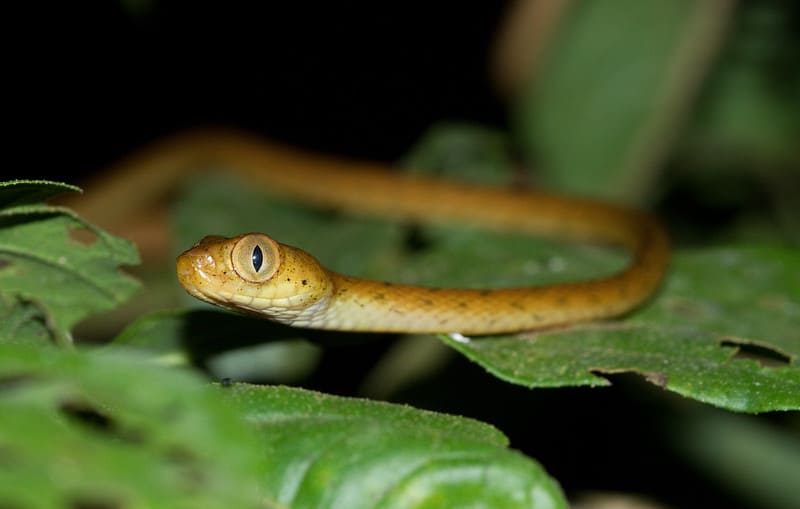
The annulated cat-eyed snake (Leptodeira annulata) is named for the vertical pupils, like a feline’s. But that’s not all you notice about this Mexican serpent. The eyes are colossal, and with the head already being 3 times as wide as the neck, it makes them seem even larger.
Its pupils are black enough that a camera’s flash is easily visible in the resulting photo, while the irises are a dirty yellow. Leptodeira annulata favours wet areas, including slow-moving streams, marshes, and seasonally flooded plains. There, it uses its big, scanning eyes to hunt its main foodstuff – amphibians. They’re also a nocturnal snake, making their bulbous eyes all the more useful for absorbing whatever light traces they can.
Leptodeira annulata measures 90-100cm, and its colours vary. Some are pale orange, but others are a richer orange with a single thick black zigzag. The annulated cat-eyed snake isn’t completely harmless, as its back fangs release a venom which causes paralysis in its prey by damaging muscle fibers. They occasionally bite people, most of which cause stinging and redness.
| 2 | Large-eyed pitviper |
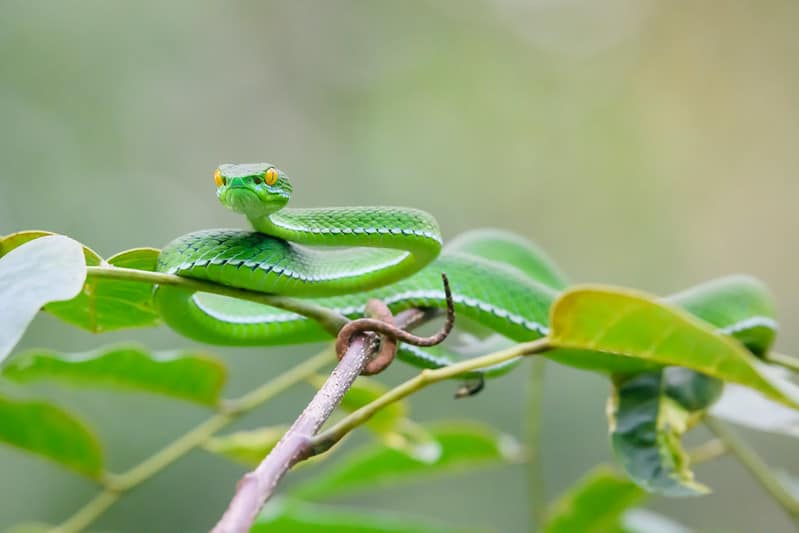
This looks like less of a snake and more of a child’s clay sculpture at school. It scales are a very bright yet basic green colour, while its eyes are a bright yet very basic yellow colour. The two contrast sharply, and also with an orange coloured tail.
Trimeresurus is a large family of snakes, collectively called the green vipers, but the eyes are where T. macrops stands out. The massive eyes have a slit-like vertical pupil, and the Latin name macrops refers to their large size.
Large-eyed pitvipers inhabit trees, but also farmland, shrubland and plains. This is one of the most dangerous big-eyed snakes. Their venom is rarely fatal, but can cause necrosis, rotting flesh which leaves lifelong deformities. Collectively, the large-eyed pit viper and its white-lipped pit viper relative are responsible for 40% of Thai snake hospitalisations. Don’t gaze into those wide, all-seeing eyes too much, or it may lull you into a trance you won’t wake up from.
| 3 | Spotted dagger-tooth tree snake |
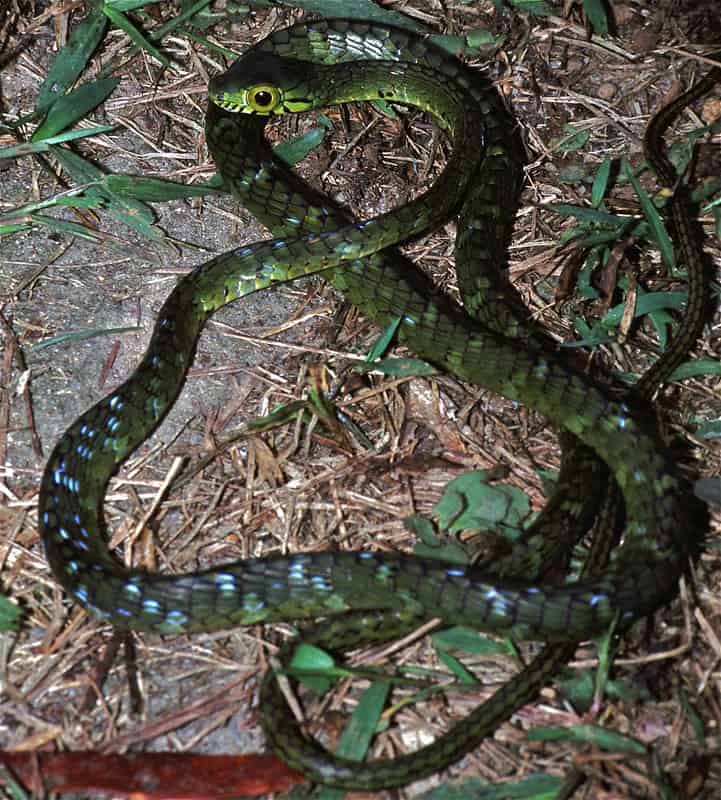
All these snakes have gigantic eyes, but the impressive thing is how different they all are. The large-eyed pitviper looks mean, but the spotted dagger-tooth tree snake (Rhamnophis batesii) just looks confused. It looks permanently dazed like somebody’s smashed a cartoon hammer over its head.
Rhamnophis batesii lives in the jungles of central Africa, particularly trees, and likes to eat amphibians. It measures 1.5-1.8 meters, and has smooth scales. The eyes have a black pupil, but covering less of the eye than some. The iris is a light green the colour of swamp gunge.
This snake also has incredible camouflage. The green scales aren’t bright green like a Halloween decoration, but rich like foliage, with many subtle shades, including occasional blue scales. Its countries include Congo, DRC, Equatorial Guinea, and Gabon. Nobody’s sure whether the spotted dagger-tooth tree snake is dangerous. It lacks front venom glands, but does possess weaker rear-fanged venom, which it must chew in over several minutes. Some rear-fangers have turned out to be deadlier than once believed recently, so scientists currently recommend caution with Rhamnophis batesii.
| 4 | Parrot snake |
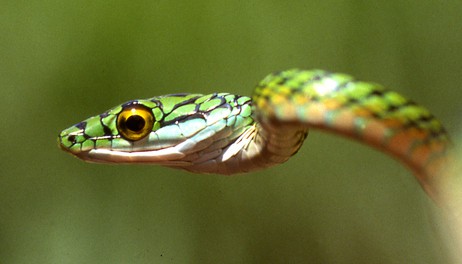
About 50% of images for the parrot snake show it snapping wildly in some unnamed photographer’s face, and its gigantic eyes add to the crazed feel. Parrot snakes (Leptophis ahaetulla) are widespread across South America, and reach 1.72 metres in length.
Their eyes are extremely large, and pop out of their head like a frog, particularly when viewed from head on. They only have a mild venom, which causes nothing more than pins and needles for several hours. Nevertheless, the eyes and propensity to bite make this an intimidating snake, particularly when you’re already lost and disoriented in the jungle. Leptophis ahaetulla is extremely aggressive and never backs down from a fight. When picked up, they bite almost invariably. This is a snake of many colours, as their backs are green, their lips are sometimes bright blue, and their irises are golden yellow. When deceased ones are stored in alcohol, they slowly turn blue over time.
This big-eyed snake lives in both disturbed and undisturbed forest, and 90% of their diet consists of tree frogs. Like the venomous Bothrops bilineatus, one of their favourites is the red-snouted treefrog. They’re sometimes seen rummaging around thick-leaved bromeliad plants for these frogs. While they commonly inhabit low tree branches, they’re also found relaxing on bushes right next to water.
| 5 | Big-eyed ratsnake |
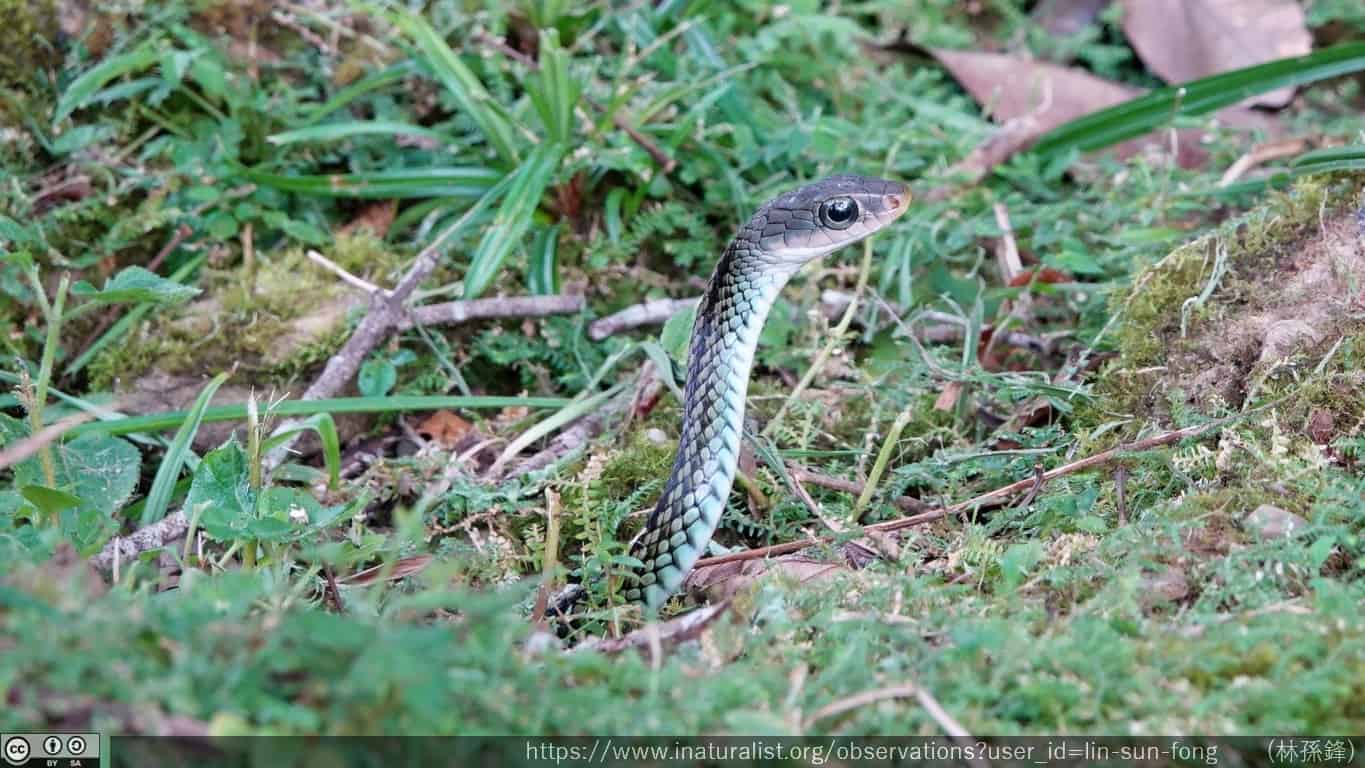
The big-eyed ratsnake (Ptyas dhumnades) is a close relative of the Indo-Chinese ratsnake common in the black market. This species already has large eyes, but the big-eyed ratsnake takes it another step. Its eyes look like green emerald jewels with a black core, matching the shade of its body, with interlocking green and black stripes. Surrounding the pupil is a thin ring of dirty yellow. The big-eyed ratsnake is a long snake as well, at 2 meters, making the eyes particularly huge compared to short species with similar proportions.
The big-eyed ratsnake isn’t dangerous to humans, lacking any venom, but it might scare people with it’s twitchy and erratic behaviour when cornered. The big-eyed ratsnake can move at extremely fast speeds. Some believe it to be the fastest snake in the whole of Asia; the Chinese name translates to “the knife that crosses the mountain”.
For once, this big-eyed snake isn’t a tree snake, although it does sleep in them at night. Ptyas dhamondes can roam anywhere from grasslands to farmlands to open forests, like its relative the oriental ratsnake.
| 6 | Thamnodynastes pallidus |
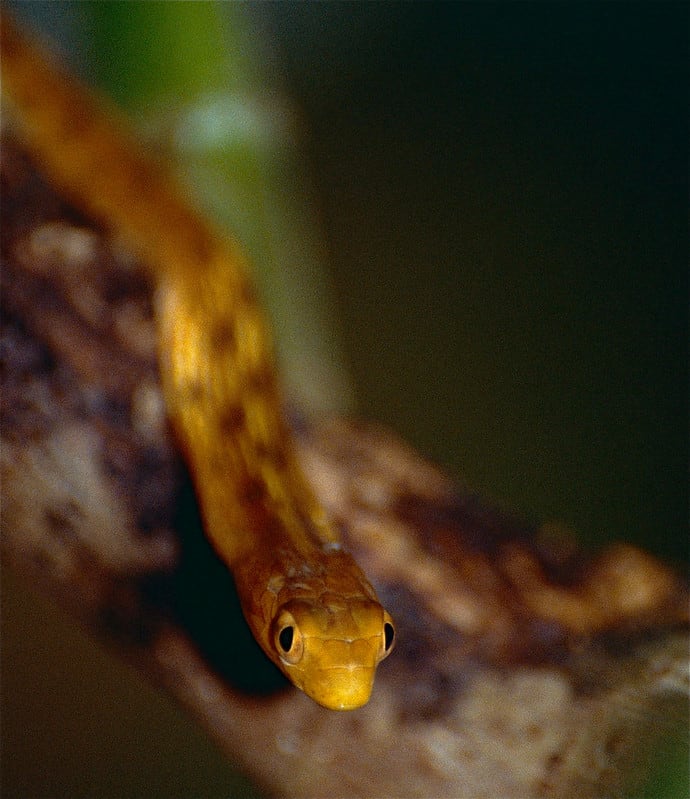
Little known, but found in many South American countries, including Argentina, Bolivia, Colombia, Guyana, and Venezuela. People might miss them as they walk past, but they won’t miss you – their eyes are enormous. Rather than black orbs, these are of the brown, crusty variety. They blend very well with their beige, sunbaked looking scales.
The eyes are a combo of yellow and black, with incredibly dark pupils bordered by a pale yellow line, with the iris being an earthier yellow. The pupils are neither vertical nor round, but oval-shaped. Thamnodynastes pallidus has such big eyes that they’re twice the diameter of the distance from its lip. They range from 19.7 to 24.2% of the diameter of its head.
Thamnodynastes pallidus has a diet heavy in frogs, including semi-lined tree frogs (Boana semilineata). They’re extremely thin and brown, and could probably be mistaken for dried out foliage if you weren’t looking carefully. They’re yet another semi-arboreal snake – we’re starting to notice a correlation.
| 7 | Wall’s bronzeback snake |
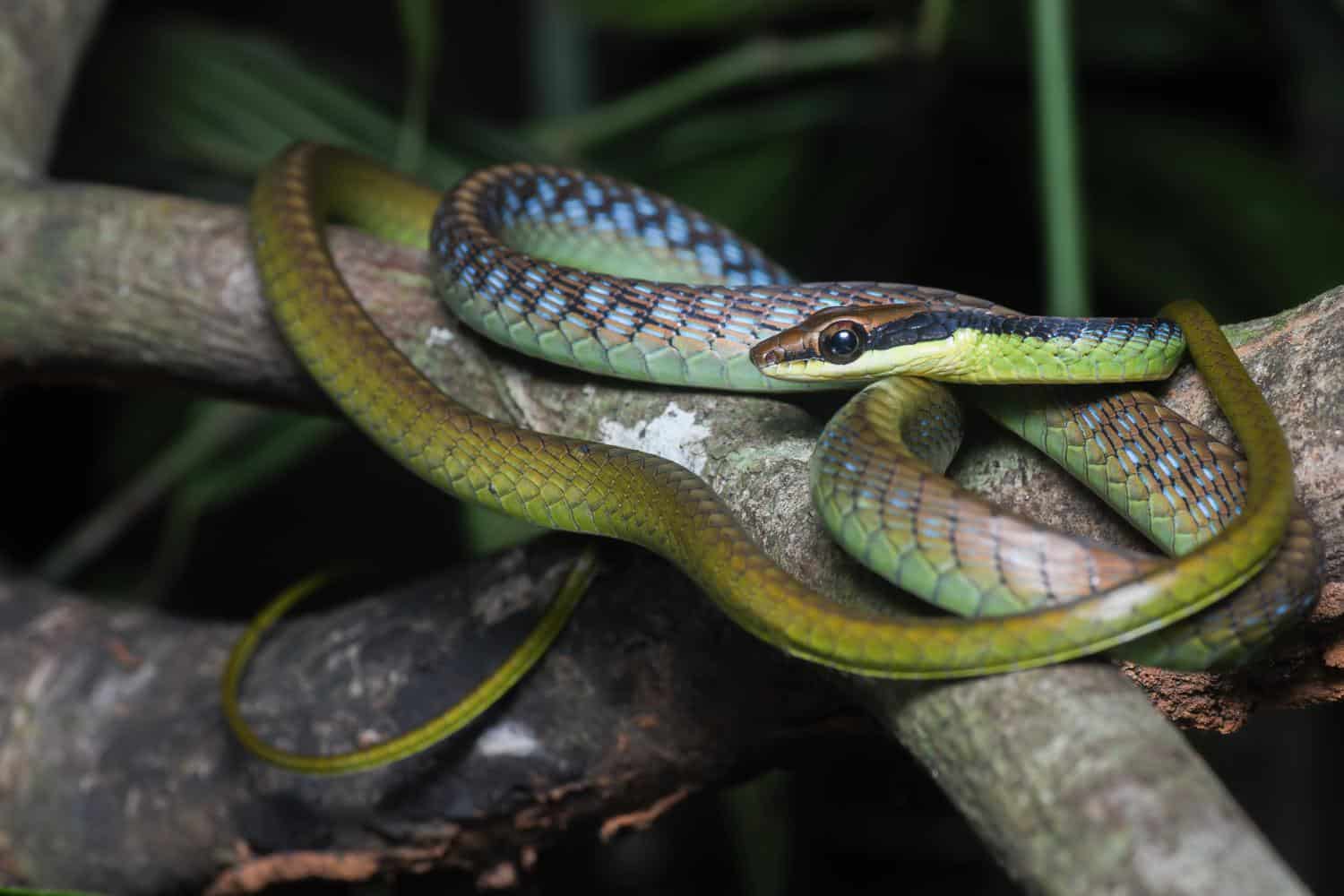
Wall’s bronzeback snake (Dendrelaphis cyanochloris) lives in Bangladesh, Myanmar, southern Thailand, western Malaysia, and India. It’s a rainforest snake, dented by logging and agriculture takeover, but common enough to easily survive, despite not being famous in the least. It’s a weird snake because in some photos, it seems to have a cuteness quotient of 8/10, while in others it looks meaner, with a downward angled scale above each eye that give it the furrowed eyebrows of a raging schoolteacher.
Either way, the eyes are huge, and make up a great chunk of its head. They almost pop up out of its skull sideways. The pupils are round and jet-black, while the iris ranges from dull brown to slate grey.
The top of its back is bronze brown, bordered by a deep black on either side, then a rich green for the rest of its body. The black stripes almost seem to run through the eye, touching the round black pupils. This snake is ultra thin, with a proportionately larger head, a similar shape to our other bog-eyed snakes. They measure 80-100cm on average.
| 8 | Malayan vine snake |
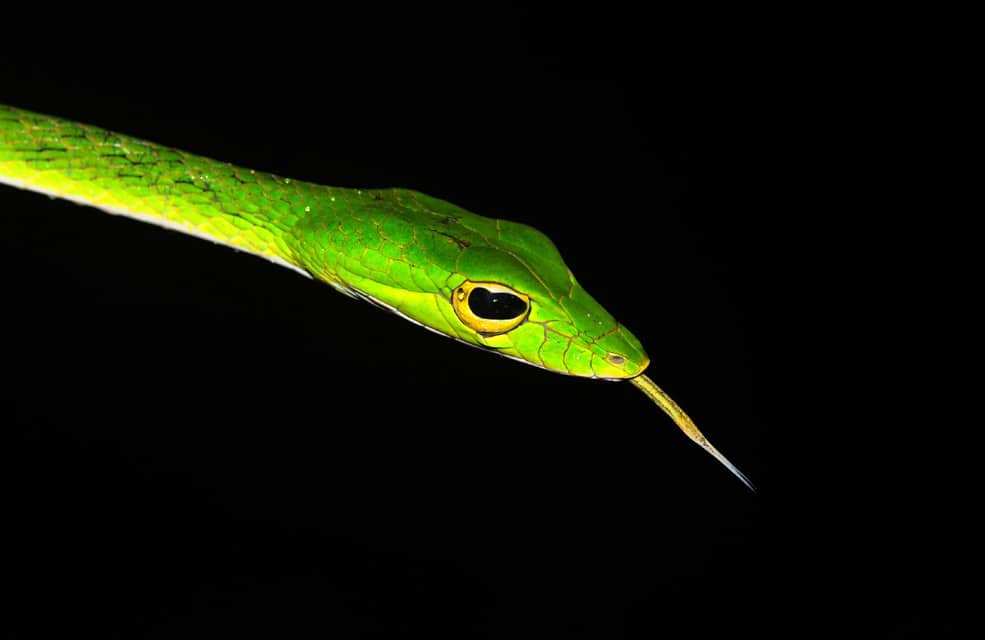
The Malayan vine snake is often confused with its close relative the Asian vine snake (Ahaetulla prasina). At a glance the two are hard to distinguish. They both have thin, vivid green bodies, which they use to swing from branches in disguise as vines. Even their tongues are a light green.
The Asian vine snake already has some of the freakiest snake eyes, with bizarrely shaped pupils that are neither circular nor vertical. Depending on the angle, they look like keyholes or sideways carrots. Ahaetulla mycterizans also possesses these weird pupils, but the difference to their cousin is that their eyes are even larger. Hence its alternative name: big-eye green whip snake.
The Malayan vine snake is far less researched than its cousin, because it sticks to wild jungles rather than parks or gardens. But it doesn’t take a 3 year research expedition while battling insects to ascertain one fact: its eyes are colossal. Another difference is that Ahaetulla mycterizans is shorter, at 1 meter versus 2 meters. It also lacks a thin yellow line on its flanks. Both snakes have a weak venom secreted from rear fangs.
| 9 | Malaysian spotted keelback |
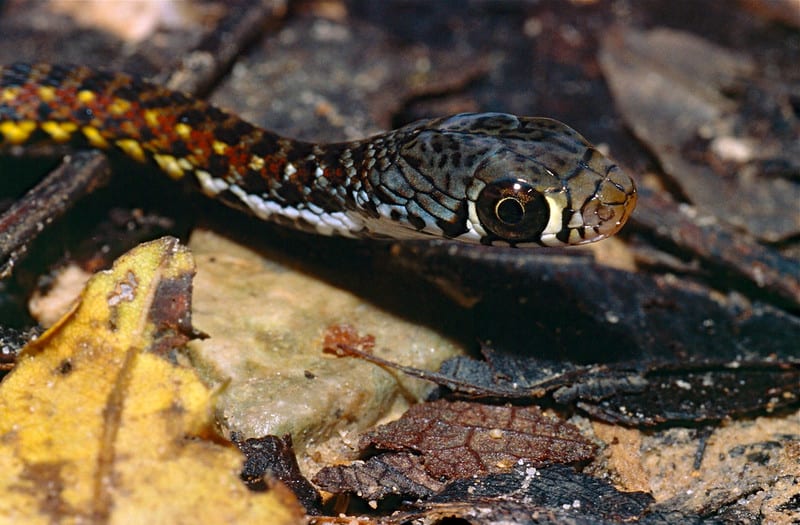
A 100cm southeast Asian snake. The Malaysian spotted keelback has a grey tongue, a white and dark grey neck, and two enormous eyes. Each pool-like eye is positioned exactly on one side of its head. The fields of vision probably don’t cross over and create 3d, but are wide enough to cover almost the entirety of the jungle on each side. The iris is medium brown, and its pupils are pitchy black and round.
This snake likes shallow streams and swampy areas within forests, but is more flexible than some keelbacks. Malaysian spotted keelbacks are very colourful, as beyond the neck, a series of random red and yellow scales kick in. This is a non-venomous species, which feeds primarily on frogs.
This big-eyed serpent has hidden itself away for decades. Originally, Xenochrophis maculatus was believed to inhabit Malaysia, Singapore, Brunei and Indonesia. Then in April 2019, one was discovered in the extreme south of Thailand, in Narathiwat Province, a relatively unexplored jungle region. If only we had as massive eyes as they do.
| 10 | Boomslang |
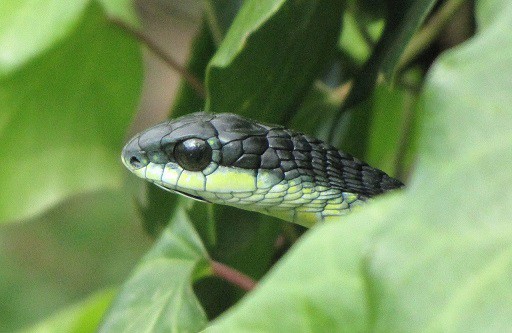
There are two factors to consider in a boomslang encounter. The first is that this notoriously venomous snake (LD50 rating 0.07mg) is shy, and would rather plunge out of a tree and scamper into the bushes than tolerate a human even in the vicinity. The second is that with their massive eyes, there’s no chance of them not noticing you.
Boomslangs have such large eyes that they have binocular vision like mammals, where the fields of vision cross to generate 3D. The large eyes are glassy and dark like a poisoned well, and blend well with their green scales. At 1-1.2m, and fairly thin, boomslangs aren’t huge but the eyes are immediately noticeable.
One theory is that they evolved in response to the chameleon’s camouflage, one animal combatant trying to outwit another using evolution. Think you can creep past one in the dark? No chance, but they rarely attack. Boomslangs cause surprisingly few deaths, with just 7 since 1954. One reason is a tiny venom yield of 1.6-8mg.
